Welcome to our blog for the Plastic in the Pacific Crusade. If you missed the earlier editions please go to category file in the footer to go back and read them. They are listed under Plastic in the Pacific. Over the coming year we will be writing regularly of our adventures and what we are seeing. In this article we write about our trip from Panama to Galapagos.
Having arrived at Balboa Yacht club late in the evening after our transit of the canal, we were shown to a mooring tightly squeezed between two other boats. Whilst there is a yacht club in Balboa, there is no marina. If you want a marina you have to go a little further on and the cost is way over the top. Even for our mooring we were paying US$32 a night. We could have anchored around the southern side of the point however it is usually fairly rolly with the southerly swells so we opted for the mooring option for the 2-3 nights we would be in Panama. One of the curious things at Balboa is that you are not allowed to use your own tender, you have to call for a water taxi to pick you up. It is free of charge but if you want to get them to pick you up quickly, then tip them $1 for a round trip. They will always come quickly if they know there is a tip in it for them.
 The first night we stayed on the boat and relaxed after our line handlers had made their way ashore. The plan for Panama was simple, provision up for the Pacific, get everything we needed for the boat and then depart to the Las Perlas Islands for a few days to relax before the Galapagos crossing. Panama is the cheapest place to provision a boat for the Pacific. Galapagos and French Polynesia are expensive and after that is the Cook Islands but that would be over 3 months away. We also had to make sure we had spares for everything as parts in the Pacific were also going to be hard to come by and expensive.
The first night we stayed on the boat and relaxed after our line handlers had made their way ashore. The plan for Panama was simple, provision up for the Pacific, get everything we needed for the boat and then depart to the Las Perlas Islands for a few days to relax before the Galapagos crossing. Panama is the cheapest place to provision a boat for the Pacific. Galapagos and French Polynesia are expensive and after that is the Cook Islands but that would be over 3 months away. We also had to make sure we had spares for everything as parts in the Pacific were also going to be hard to come by and expensive.
In the morning we went ashore and checked in with the marina. Then we set about finding a taxi. There are good and bad stories of Taxi’s in Panama. Going with a recommended driver is the best option. We had been recommended to call a guy called Roger (6717 6745). He has a van and will never try to overcharge you. However he wasn’t available so we went with another guy who was at the yacht club called Miquel. He only had a small car but was very helpful and was $10 per hour which is about right for the area. We first tried to hunt down spare parts for the boat and the Abernathy’s in town was the best option. They had most of what we wanted however there were a few other items so we ran all over town finding things. The main thing we needed was to get additional cordage for our anchor. In the Pacific you may have to anchor in waters of 30-40m. With 50m of chain onboard, that only gave us a range of 15-18m to anchor in. Chain was out of our budget so we went with nylon rope and bought 100m which would give us a good anchoring depth range. We could put 50m of chain on the bottom and still be in 30-40m of water. The best place we visited was the Ferreteria (Hardware store) near Ray’s supermarket. It had lots of little things we needed, not really boat parts but bolts and shackles etc.
We then went to Ray’s supermarket although we had wanted to go to Riba Smith as we had been told they had the best range of stuff. I think Miquel had a rewards card for Ray’s so we ended up there. The shop was large and we were filling trolleys pretty quickly. 2/3rds of the way through the aisles and we had 2 large trolleys packed high. We had large bags of rice, boxes of milk and juice, heaps of cereals and everything in bulk that would last. Miquel found us and went and got a third trolley and followed Annika around with it so we filled it too. At the checkout, three packers came to help us and found boxes to put everything in. I just hoped everything would fit in the car. Out in the carpark and it was a mission. The poor little car (same size as a Mazda 3) was very low in the back. We managed to get back to the marina and they packed all the goods on a trolley with a guy who would take it down the wharf to the boat. The price for this guy is by way of tipping. We failed in our first attempt by not asking how much. At the end of the jetty once unloaded we gave him a couple of dollars and he whinged and complained saying it should be $10. We were tired and wanted to get to our yacht so we gave him his money. Still regret it as we obviously over paid him.
Back on the boat and we packed everything away as best we could. There was a lot of food but we found places all throughout the boat. We hadn’t found any gluten free food for Annika so she was a little worried. She did some research and sure enough, Riba Smith had all the good stuff. We decided we would go there in the morning. We also needed to arrange fuelling. We had wanted to stay 2 nights only but we would need a third to make sure we were ready. I was trying to get these blogs up to date but would fail. It would have to wait until the Galapagos where we would be for 3 weeks at least. Riba Smith was awesome and this time we had Roger. He was brilliant and I wish we had his van the first day, would have fitted everything easily. That afternoon we researched Galapagos and contacted our agent, Johhny Romero. You have to enter Galapagos using an agent. We had heard that the fees were expensive but we had no choice, it was the Galapagos and it was a big tick on the bucket list to go and dive there. You also want to break up the big leg to Marquesas. It is nearly 4000nm from Panama to Galapagos so a pit stop in Galapagos after nearly 900nm would be ideal.
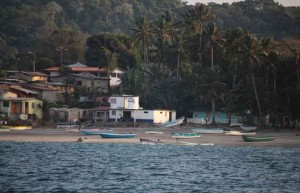 Whilst researching the entry requirements for Galapagos we realised we needed a Fumigation certificate. I quickly emailed our Panama Canal Agent Erick and he would arrange it for the following morning. We would meet his wife at the fuel dock. So in the morning we went in to fuel up. We got our fuel and then Erick’s wife turns up, gives us a certificate and takes the US$40 for the service. Interesting fumigation we had just had completed, quick too!!!! By 1000 we had departed Panama and were heading to Las Perlas Islands 38nm away. The plan was to go to Isla Pedro Gonzalez and anchor up there. The wind was perfect and we ran the spinnaker half way there with 2 knots of current behind us all the way. When we gybed, the wind had moved perfectly for us and then a storm started brewing so we just 2 sail reached into the northern bay and found another boat to anchor with. One thing we had been warned of was to ensure you anchor with another boat in Panama to avoid possible risk of being boarded. I think it relates more to the mainland but we wouldn’t risk it even in the islands.
Whilst researching the entry requirements for Galapagos we realised we needed a Fumigation certificate. I quickly emailed our Panama Canal Agent Erick and he would arrange it for the following morning. We would meet his wife at the fuel dock. So in the morning we went in to fuel up. We got our fuel and then Erick’s wife turns up, gives us a certificate and takes the US$40 for the service. Interesting fumigation we had just had completed, quick too!!!! By 1000 we had departed Panama and were heading to Las Perlas Islands 38nm away. The plan was to go to Isla Pedro Gonzalez and anchor up there. The wind was perfect and we ran the spinnaker half way there with 2 knots of current behind us all the way. When we gybed, the wind had moved perfectly for us and then a storm started brewing so we just 2 sail reached into the northern bay and found another boat to anchor with. One thing we had been warned of was to ensure you anchor with another boat in Panama to avoid possible risk of being boarded. I think it relates more to the mainland but we wouldn’t risk it even in the islands.
Our anchorage was behind a small island and north of a little village. The village was quite nice, but with such a large island I was unsure why they stacked all the houses in one area. There is a new marina being built here and a power boat went in there. Maybe we should have too. It is still an anchorage at this time but we were happy to be out in clear water near and island. Hindsight is a wonderful thing as the swell rolled through all night making it quite uncomfortable. We had been told by other cruisers that if we can anchor on the West side where a resort is being built, then go ashore, the security guy will tell you that you can’t access the land here. Ask for Mangoes and avocados and he will come back with heaps for $1. Well we didn’t go to the west side due to wind and swell. We would later find out that it was the ‘Other’ west side that we should have gone to. Yes we should have been on the east side the first night, no swell and we would have got our mangoes and avocados.
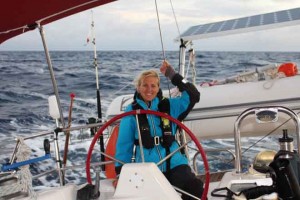 In the morning we decided to find a better anchorage. We headed to Isla San Jose that had a large bay on the southern side and assumed it would be a perfect anchorage. We needed to scrub the bottom of the boat as entering the Galapagos you have to have a perfectly clean hull, no barnacles in inlets or on the hull at all. This is the biggest factor of entering the Galapagos. If you aren’t clean, then they will send you out 40nm to clean the boat before you can re-enter. So we sailed past the eastern side and saw the resort but no other boats so it wasn’t an option. It looked like an oasis though. Real shame no one was there. So we headed down to San Jose. San Jose is privately owned so you can’t go ashore either. You can use the beaches but nothing more. The anchorage on the southern side is paradise, like a movie set with palm trees on crystal clear waters. There was a southerly swell rolling in but it wasn’t too bad over in the western end of the bay. We anchored over there but we were alone. Over lunch Annika and I discussed our options. She wasn’t happy to be alone, even in this paradise. After lunch we jumped in to scrub the bottom. I went in first and got a small sting and that was that. Lots of little jellies in the water so knowing the boat was fairly clean, we just decided to head off to Galapagos. We had checked the weather and it was going to be light anyway so best to start the journey, after all, that was where we wanted to be.
In the morning we decided to find a better anchorage. We headed to Isla San Jose that had a large bay on the southern side and assumed it would be a perfect anchorage. We needed to scrub the bottom of the boat as entering the Galapagos you have to have a perfectly clean hull, no barnacles in inlets or on the hull at all. This is the biggest factor of entering the Galapagos. If you aren’t clean, then they will send you out 40nm to clean the boat before you can re-enter. So we sailed past the eastern side and saw the resort but no other boats so it wasn’t an option. It looked like an oasis though. Real shame no one was there. So we headed down to San Jose. San Jose is privately owned so you can’t go ashore either. You can use the beaches but nothing more. The anchorage on the southern side is paradise, like a movie set with palm trees on crystal clear waters. There was a southerly swell rolling in but it wasn’t too bad over in the western end of the bay. We anchored over there but we were alone. Over lunch Annika and I discussed our options. She wasn’t happy to be alone, even in this paradise. After lunch we jumped in to scrub the bottom. I went in first and got a small sting and that was that. Lots of little jellies in the water so knowing the boat was fairly clean, we just decided to head off to Galapagos. We had checked the weather and it was going to be light anyway so best to start the journey, after all, that was where we wanted to be.
The journey from Panama to Galapagos is a tricky one. You have to transit the Inter Tropical Convergence Zone (ITCZ) commonly known as the ‘Doldrums’. In the first half of the trip you have current with you, then it heads west before turning north-west the closer you get to Galapagos. You have to avoid the coast of Columbia, that is not safe yet the routing takes you south to get into the south-easterley winds that will take you across to the islands. Our forecast had no wind for the first 3 days, well nothing more than 8 knots so we had it in our mind that whilst we didn’t want to, we would motor until we got to the southerly winds. So it was a huge surprise when the first 24 hours we sailed with the spinnaker up and had good speed. The winds were opposite direction to forecast and much stronger. By the second afternoon however, it was glass out time.
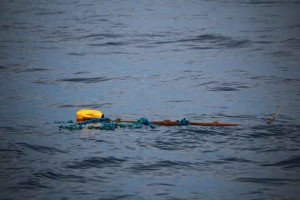 Glass outs are amazing at sea. Yes they are frustrating for a sailor but you see so much. You should see any fish or sea life on the surface as any ripple is easy to spot, however the biggest thing we started seeing was plastic debris, and I mean lots of it. We could not sail 100m without spotting another piece, be it polystyrene, plastic bottles, cups, pieces of foam, you name it, it was there. It was horrible to see. For 3 days we would have light winds and the amount of debris seen was extraordinary. We as a human race have really failed our oceans. We treat them like a garbage can yet the same oceans are our life line. Without them 60-80% of the world’s oxygen disappears, a major source of food, and more recently cures to all sorts of diseases. Lots of people are out cleaning it up and making lots of money out of their campaigns, but here at Ocean Crusaders, our mission is to put these companies out of business. Prevention is better than a cure is what we teach. We need to stop using plastics so we don’t have to clean them up. If we put the money we are spending on cleaning up the problem into alternative products, then we would have a much better future. If you’re enjoying these blogs then quite simply we need you to make changes in your lives to live with less plastic. This means making choices at the supermarket. Choose items with less plastic. Even if your rubbish goes to the tip, it still makes a difference. Clean Oceans really will make us all winners!!!
Glass outs are amazing at sea. Yes they are frustrating for a sailor but you see so much. You should see any fish or sea life on the surface as any ripple is easy to spot, however the biggest thing we started seeing was plastic debris, and I mean lots of it. We could not sail 100m without spotting another piece, be it polystyrene, plastic bottles, cups, pieces of foam, you name it, it was there. It was horrible to see. For 3 days we would have light winds and the amount of debris seen was extraordinary. We as a human race have really failed our oceans. We treat them like a garbage can yet the same oceans are our life line. Without them 60-80% of the world’s oxygen disappears, a major source of food, and more recently cures to all sorts of diseases. Lots of people are out cleaning it up and making lots of money out of their campaigns, but here at Ocean Crusaders, our mission is to put these companies out of business. Prevention is better than a cure is what we teach. We need to stop using plastics so we don’t have to clean them up. If we put the money we are spending on cleaning up the problem into alternative products, then we would have a much better future. If you’re enjoying these blogs then quite simply we need you to make changes in your lives to live with less plastic. This means making choices at the supermarket. Choose items with less plastic. Even if your rubbish goes to the tip, it still makes a difference. Clean Oceans really will make us all winners!!!
We steamed at 1200rpm which means we only use less than 1 liter an hour and were doing 5.8 knots over the ground with the current helping. Each shift would be frustrating as we would launch sails and pull them back in several times as clouds fed us wind. You would think you’ve finally made the southerlies, and then they would die. For cruisers with a bit of time, the alternative of heading to mainland Ecuador is a real option, although this too is upwind but it will make the trip across to Galapagos easier. Eventually we would start to see the southerlies filling in and we could finally set sail, however the currents by this stage were against us, pushing us North West, away from the Galapagos. The winds were hard on the nose, even though our forecasting had said we should be beam reaching. In fact the forecast the entire way across this passage was pathetic. I can’t say it any other way. There were times we were meant to be sailing upwind and we would have the spinnaker up. Others had us on port tack and we would be on starboard tack with winds the complete opposite direction. Even the southerlies that we had which should have been easier to forecast, were 20 degrees rotated from forecast. It was very frustrating but we were sailing, albeit hard on the nose.
At one stage I woke up from a sleep and Annika told me we had a problem. The stove had broken a gimbal. I recalled my previous Beneteau 51 that had a similar problem when we bent her over a wave and it jumped out of its gimbals. However this had broken a support but with a bit of ingenuity we managed to replace it with a bolt and a few washers. What we didn’t know is that we had pierced the hose and it would ultimately leak out precious gas. Luckily it wasn’t anything worse. But filling European gas bottles in Galapagos was probably not going to happen so wasting a whole bottle over 4 days, they would usually last a month, was not good.
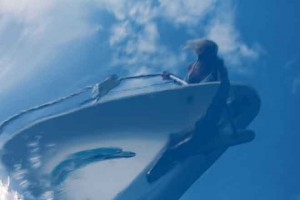 We started to motor sail with about 36 hours to go to get a bit of extra height however early one morning, whilst trying to sleep I heard the engine stalling and shouted to Annika to stop the engine. I tried to sleep more and would fix it later but couldn’t get my mind to stop thinking about the issue. I had hoped it was simple. And it did prove simple. We checked the fuel filters and they were empty. The line between the tank and first filter was blocked. I pulled out the intake hose to find it blocked solid with gunk. Obviously the boat bouncing upwind had moved it in the tank. I couldn’t even pull it out easily. The metal hose that goes in the tank was totally blocked. I couldn’t think of a way to blow it out but Annika said we should use one of the dive tanks so I disconnected it and took it out the back and used a dive tank to shoot the gunk out. I re-installed it and primed the engine and it turned over straight away. It was a real relief. But we would need to treat our fuel as soon as we could as it was ‘black death’, a fungus, forming in our tank, not something you want in the remote regions of the pacific.
We started to motor sail with about 36 hours to go to get a bit of extra height however early one morning, whilst trying to sleep I heard the engine stalling and shouted to Annika to stop the engine. I tried to sleep more and would fix it later but couldn’t get my mind to stop thinking about the issue. I had hoped it was simple. And it did prove simple. We checked the fuel filters and they were empty. The line between the tank and first filter was blocked. I pulled out the intake hose to find it blocked solid with gunk. Obviously the boat bouncing upwind had moved it in the tank. I couldn’t even pull it out easily. The metal hose that goes in the tank was totally blocked. I couldn’t think of a way to blow it out but Annika said we should use one of the dive tanks so I disconnected it and took it out the back and used a dive tank to shoot the gunk out. I re-installed it and primed the engine and it turned over straight away. It was a real relief. But we would need to treat our fuel as soon as we could as it was ‘black death’, a fungus, forming in our tank, not something you want in the remote regions of the pacific.
As we closed the coast of Galapagos we were meant to have the winds back to the east so we could head further south and we should have been beam reaching into the islands. We were heading to San Cristobal Island as we had hoped to get a last minute autograph to allow us to visit the three islands. You are meant to apply for this 2 months before your arrival but we hadn’t seen that and Johhny was trying to get us one. You have two options as a cruising sailer. Apply for a 60 day Autograph that allows you to visit 3-5 ports, or apply for a 20 day one port stay. We would ultimately fail in our attempt to get the autograph so we would get a 20 day stop at one port. There are some very strict rules in Galapagos which we will go through in our next blog. We decided that we would go to Santa Cruz as that was where the best diving was so we would bear away a few degrees in the last day and only in the last 50nm would we actually be beam reaching.
On the last two evenings into Galapagos we would start getting these large booby birds hunting with us at night. They would fly along at the bow and with our navigation lights lighting the way, and our bow scaring fish out of the water, they would wait for a scared fish to jump out of the way and dive in and get their feed. They were the Nacra Boobies that hunt offshore a lot. It was fascinating to watch. Bird life was increasing a lot. We were approaching one of the most unique wildlife sanctuaries in the world and these bird sightings only made our excitement greater.
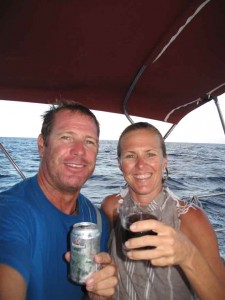 At 0757 local time on the 11th December we would have a special moment. It would call for a drink, even though it was morning. We also went for a swim. It was time to cross the equator from north to south. 0800 was a shift change so it was perfect timing. As we counted down the latitude I managed to capture the 00’00.000 on Maxsea. We gave a toast to Neptune, and had a swim. As we stopped the boat on the equator, with the current heading north west, we quickly passed back into the northern hemisphere and would have to transit the equator again. This was probably the last time Susky would see the northern hemisphere.
At 0757 local time on the 11th December we would have a special moment. It would call for a drink, even though it was morning. We also went for a swim. It was time to cross the equator from north to south. 0800 was a shift change so it was perfect timing. As we counted down the latitude I managed to capture the 00’00.000 on Maxsea. We gave a toast to Neptune, and had a swim. As we stopped the boat on the equator, with the current heading north west, we quickly passed back into the northern hemisphere and would have to transit the equator again. This was probably the last time Susky would see the northern hemisphere.
Our arrival time in Puerto Ayora Santa Cruz, well you recall that I have a habit of arriving at night, this would be no different, however it wasn’t the stupid hours of the morning, it was about 2100. Heading into the port, you could see it was open to the southerly swells. I had checked out google maps before departing Panama and saw that you could tuck yourself away behind a point but there were lots of boats there. Arriving at night was not ideal and as we approached, there were lots of bigger power boats anchored out in the swells. These are the live-a-board cruisers and they were rolling all over the place.
We cruised in slowly with a keen eye on the depth sounder. There were lots of lights and boats but trying to find a spot to anchor was really hard. This little port was jam packed and to cap it off, there was a really loud party going on ashore so hearing Annika at the bow was impossible. Both of us thought that with all these environmental regulations, why then was it O.K to have noise pollution, and it was ridiculously loud. You could hardly hear the people screaming between the PA speaker noise. We nearly ran over a stern anchor of one boat, not realising it was out. I couldn’t hear Annika screaming but saw it late and managed to stop in time. A lot of boats here use stern anchors to point into the swells and I will give you one piece of advice, you need one. We eventually found a spot to anchor but wouldn’t run a stern anchor the first night. It would be a big mistake as we rolled all over the place as the boat got side onto the swells. Luckily the music stopped at 1030 and we were able to enjoy our drinks in peace however in my tiredness and with the frustration of the music and the rolling swells and the fact it had taken 4 attempts to get an anchor to bite, I was almost ready to sail onto the Marquesas.
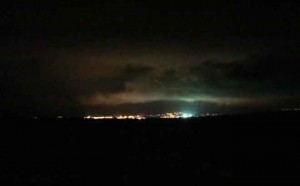 Was Galapagos going to be a huge let down? We had heard so many good things about the place and it was a dream to come here. I’d hope our horrible arrival would turn around and in the morning that everything would be great. Did it? Or was the Galapagos a huge let down? Even more so, would we be allowed to stay, would we pass the environmental inspection?
Was Galapagos going to be a huge let down? We had heard so many good things about the place and it was a dream to come here. I’d hope our horrible arrival would turn around and in the morning that everything would be great. Did it? Or was the Galapagos a huge let down? Even more so, would we be allowed to stay, would we pass the environmental inspection?
In our next edition we dive and explore Santa Cruz Galapagos.
Ocean Crusaders are out to change the way people treat our oceans. Our online education program is free to download at www.OceanCrusaders.org/education where children can learn of the issues our oceans are facing and how they can make a difference. The Plastic in the Pacific Crusade is about educating the South Pacific Islands, finding out what is happening in these islands and updating our programs. You can join us in the Pacific and see for yourself what we do.
Ocean Crusaders Plastic in the Pacific Crusade is proudly supported by: Cressi Dive Gear, Gill Marine, Keen Footwear Australia, Barz Optics Sunglasses, Maxsea Navigation Software, Digital Diver Cairns, LED Dive Lights Australia, Boat Names Australia, Predictwind Weather & Sail-world.com
[cincopa AILAfKtb7eRl]
SIGN UP FOR OR BLOGS